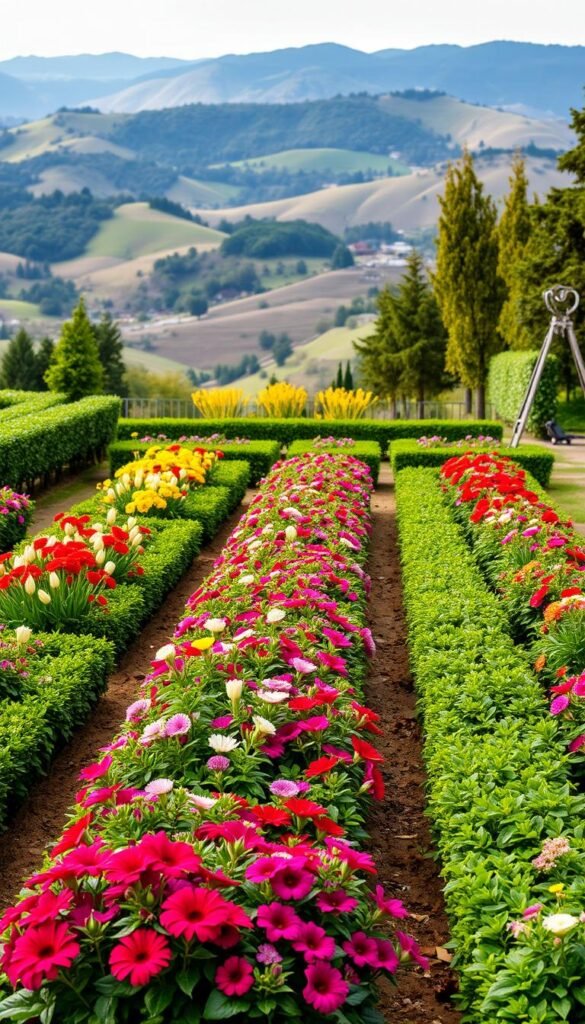Imagine stepping into your outdoor space where every herb, flower, and vegetable grows exactly where it should. No more tangled roots or crowded plants—just a thriving, easy-to-manage paradise. This isn’t a fantasy. With smart layouts and strategic planning, you can create planting areas that boost productivity while looking stunning.
Good design turns chaos into order. Instead of guessing where to place your tomatoes or herbs, you’ll learn how to arrange them for optimal sunlight and airflow. Even small patios or balconies can become lush, efficient growing zones. It’s not about having more space—it’s about using what you have better.
Think beyond straight rows. Layered planting, companion crops, and vertical structures work together to save space and reduce pests. These systems simplify watering and harvesting, letting you enjoy your hobby instead of wrestling with it.
Ready to grow more with less effort? The methods ahead will help you craft a space that’s as practical as it is beautiful. Your neighbors might even ask for your secret—and you’ll have plenty to share.
Introduction to Clever Garden Bed Concepts
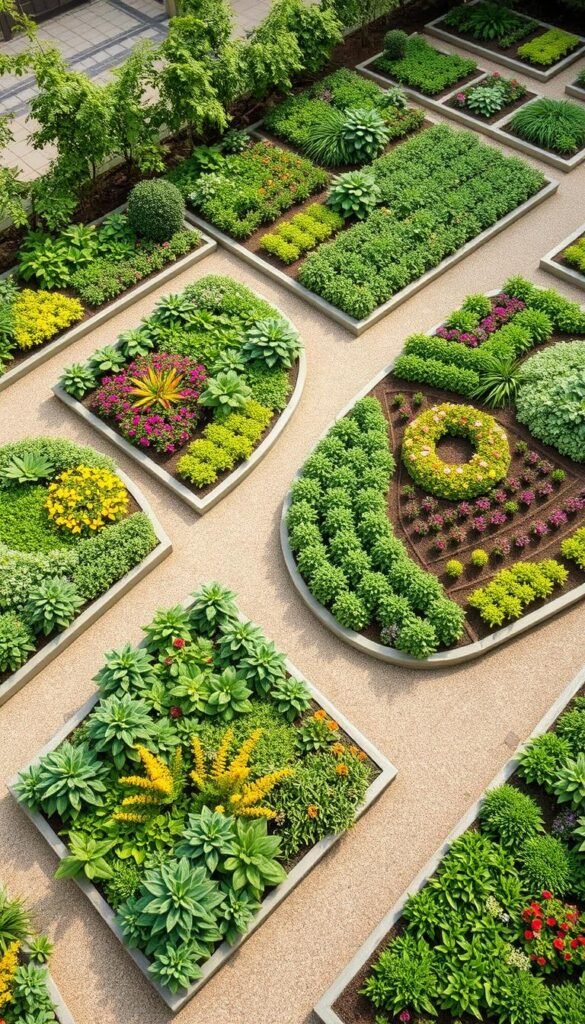
Strategic layouts turn even small yards into thriving plant ecosystems. This approach focuses on creating partnerships between crops rather than just filling empty dirt. You’ll work with nature instead of against it, using space like a master chess player.
What Thoughtful Cultivation Means for Your Plot
Instead of scattering seeds randomly, consider how plants interact. Tall sunflowers might shade delicate lettuce, while basil repels tomato pests naturally. These relationships boost yields up to 30% compared to traditional row setups.
Creating Ideal Conditions in Your Space
Start by mapping sunlight patterns for 3 days. Notice where shadows fall and which areas stay dry after rain. This intel helps position crops needing six hours of sun versus those thriving in partial shade. A square foot gardening layout works wonders for maximizing limited areas.
Soil testing kits ($15-20 at hardware stores) reveal pH levels and nutrient gaps. Amend earth based on these results before planting – your future self will thank you during harvest season. Well-planned spaces reduce weeding time by 40% while increasing accessibility.
Benefits of Raised Beds and Organized Planting
Growing food in elevated structures solves common ground-level challenges. Unlike traditional plots, these systems let you craft ideal conditions for each plant. This approach works particularly well when native earth lacks nutrients or drains poorly.
Custom Soil and Water Flow Advantages
You decide what fills your planting area. Mix compost, peat moss, and vermiculite to create fluffy, nutrient-rich earth. This tailored blend helps roots spread easily and access food.
Elevated setups drain excess water 2-3 times faster than compacted ground. No more puddles drowning your carrots after summer storms. The table below shows key differences:
| Feature | Raised Systems | Ground Planting |
|---|---|---|
| Soil Customization | Full control | Limited options |
| Drainage Speed | Fast | Variable |
| Spring Readiness | 1-2 weeks earlier | Depends on frost |
Protection and Productivity Boosters
Defined borders create natural barriers against slugs and crawling insects. Spot trouble quickly when plants grow at waist level. Pair marigolds with tomatoes to repel nematodes naturally.
Tighter spacing in controlled areas increases output. One study showed 27% more veggies per square foot compared to row gardens. Plants thrive when they’re not fighting neighbors for resources.
Clever Garden Bed Ideas for Organized Planting
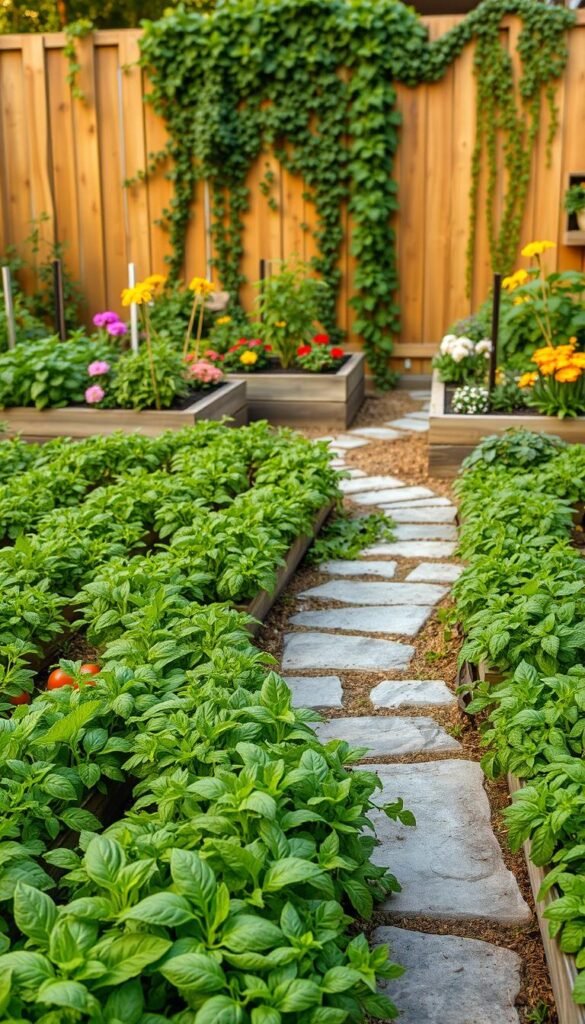
Transform your outdoor area into a well-ordered paradise where every plant has its perfect spot. Thoughtful layouts combine beauty with practicality, letting you grow more while keeping maintenance simple. Start by sketching zones that match your daily routines – place herbs near the kitchen door, and flowering shrubs where they’ll frame your patio view.
Geometric patterns add rhythm to your space. Try hexagonal herb clusters or spiral-shaped flower arrangements. These shapes create natural boundaries while maximizing planting areas. Pair circular metal frames with rectangular wooden boxes for contrast that catches the eye.
Smart layouts include strategic walkways and tool stations. Leave 18-24″ between structures for comfortable kneeling and wheelbarrow access. Use gravel paths or stepping stones to define traffic flow – this reduces soil compaction around roots.
| Design Element | Visual Appeal | Functional Benefit |
|---|---|---|
| Tiered beds | Adds depth | Easier harvesting |
| Mixed materials | Textural interest | Custom drainage |
| Themed sections | Color coordination | Simplified care |
Rotate crops effortlessly by designing modular sections. A raised garden with removable panels lets you swap soil mixes for different plant families each season. Mark calendar dates directly on weatherproof tags attached to bed edges.
Your space should evolve with your needs. Start small with three distinct zones, then expand as you discover what works. The best bed ideas grow alongside your gardening skills, always balancing fresh beauty with tried-and-true functionality.
DIY Materials and Sustainable Options
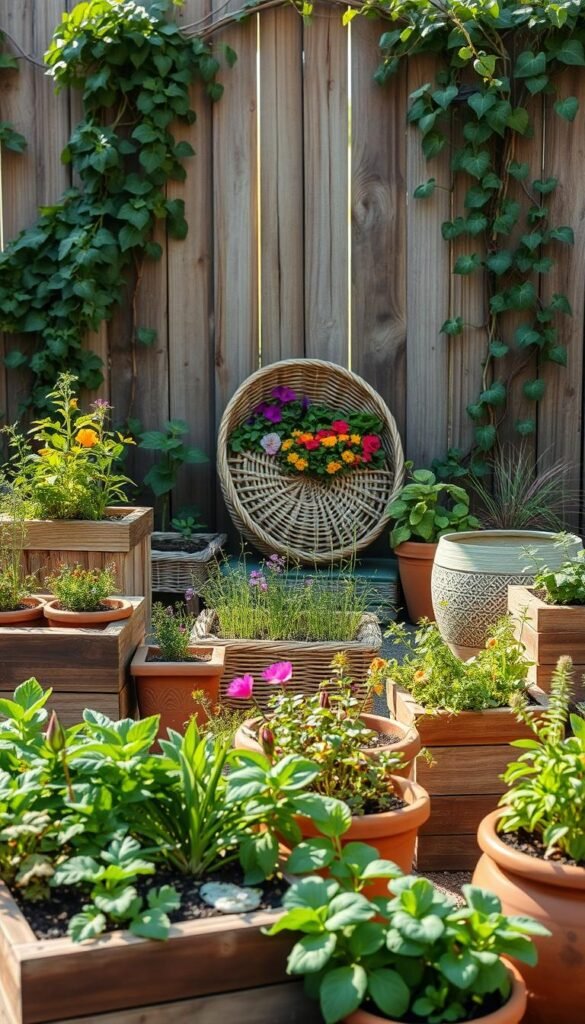
Building lasting planting spaces starts with smart material choices. Whether you’re crafting raised beds or decorative borders, your selections impact both aesthetics and longevity. Quality beats quick fixes every time—those who skimp now often rebuild later.
Choosing Natural, Affordable, and Durable Materials
Cedar remains a top pick despite rising costs. Its natural oils resist rot and pests, outlasting cheaper woods by years. One gardener notes: “My cedar beds still look great after a decade—pine replacements lasted two seasons.”
Untreated hardwoods and stone offer similar durability. Metal troughs work well for modern looks, while brick edges add rustic charm. Compare popular options:
| Material | Cost | Lifespan |
|---|---|---|
| Cedar | $$ | 10-15 years |
| Recycled plastic | $ | 20+ years |
| Reclaimed wood | $ | 5-8 years |
| Salvaged stone | $$$ | Lifetime |
Repurposed and Recycled Options for Budget-Friendly Projects
Old pallets become instant planters with some sanding and linseed oil. Check for HT stamps (heat-treated, not chemical-soaked). Chipped concrete chunks make free retaining walls when stacked creatively.
Recycled plastic lumber never splinters and handles heavy soil loads. Local demolition sites often give away usable bricks or metal sheets. Your most unique beds might come from leftover materials—think wine barrels or retired library shelves.
Remember: Sustainable choices save money and reduce waste. A mix of new and repurposed materials often creates the most functional—and personal—outdoor spaces.
Ergonomic Raised Beds for Comfort and Ease
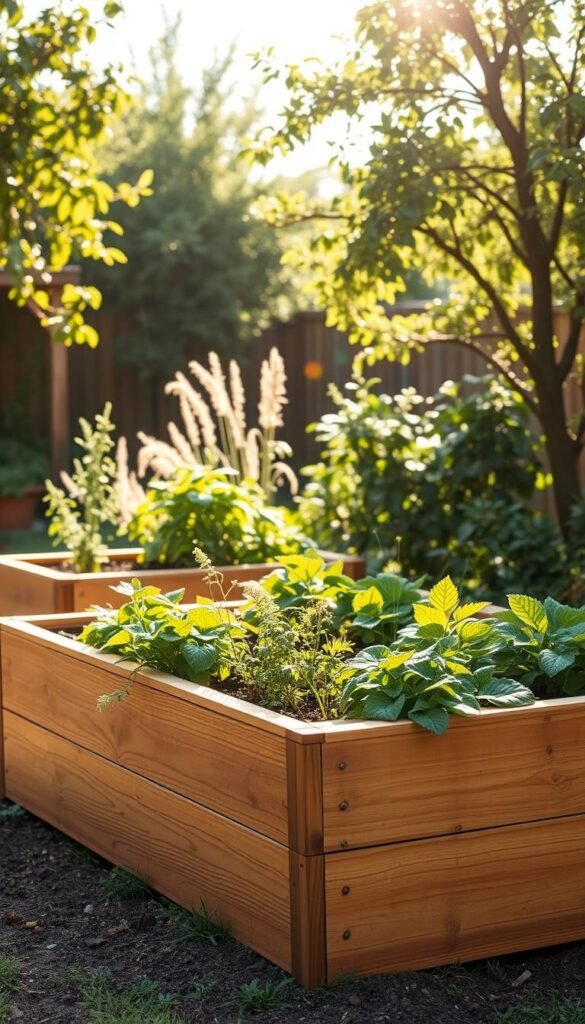
Tired of sore muscles after tending your plants? Elevate your setup with waist-high designs that keep your spine happy. These raised beds let you nurture greens without crouching or kneeling – your back will thank you at sunset.
Designing Waist-High Garden Beds
Ideal heights range from 24″ to 36″, aligning with most adults’ hip levels. Measure from your wrist to elbow while standing – this determines your perfect working height. A build a raised bed garden project becomes life-changing when customized to your body.
See how ergonomic designs improve daily tasks:
| Feature | Traditional Beds | Waist-High Beds |
|---|---|---|
| Working Position | Bent over | Upright stance |
| Harvest Speed | Slow | 2x faster |
| Weeding Comfort | Knee strain | Standing ease |
Higher planters mean clearer visibility. Spot aphid colonies before they spread or catch ripe tomatoes at peak redness. You’ll complete gardening tasks with precision – no more overlooked issues hiding at ground level.
Seniors and those with mobility challenges particularly benefit. One user shared: “My arthritis doesn’t stop me anymore – I can deadhead flowers for hours!” These accessible setups let everyone enjoy growing their favorite plants without physical barriers.
Incorporating Trellises and Vertical Supports
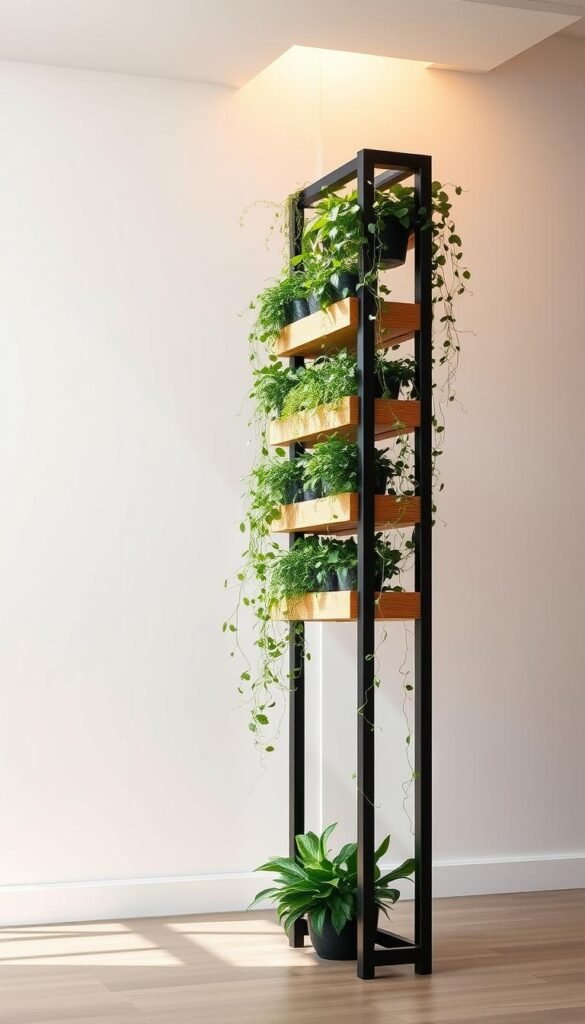
Turn your garden into a living sculpture by guiding plants upward. Vertical systems transform unused airspace into productive zones while adding dimension to your layout. This approach works wonders for plants that naturally reach for the sky, creating edible walls and floral curtains.
Using Trellises for Climbing Plants
Vining crops thrive when given proper support. Pole beans spiral around bamboo stakes, while cucumbers grip wire grids with curly tendrils. A study by Urban Gardening Institute found vertical-grown tomatoes yield 40% more fruit than ground-sprawling varieties.
| Plant Type | Ground Growth | Vertical Growth |
|---|---|---|
| Peas | Prone to rot | 97% healthier pods |
| Melons | Space hog | Compact + easier to monitor |
| Flowering vines | Messy spread | Controlled blooms |
Building Teepee-Style and DIY Trellis Walls
Teepee structures offer playful functionality. Arrange six 6-foot poles in a circle, tying tops with jute twine. Morning glories will cloak the frame in weeks, creating a leafy fort kids adore.
For quick walls, try this DIY trellises guide using repurposed materials. Old bicycle wheels become circular supports for sweet peas. One gardener shared: “My bean teepee doubled as a shaded reading nook by July!”
Vertical systems solve multiple challenges. They improve air flow around plants, reduce pest access, and make harvesting a breeze. Best part? You’ll gain valuable space for additional crops below.
Creative Pathways and Grid Wiring Solutions
Your garden’s walkways do more than guide your steps—they shape your entire growing experience. Thoughtful paths protect soil structure while creating visual flow. Pair them with smart organization tools to turn chaotic plots into efficient, eye-catching spaces.
Establishing Accessible Walkways Between Beds
Skip the gravel crunch underfoot. Brick or stone pavers create stable surfaces that last decades. Unlike loose materials, they won’t shift during heavy rains or scatter into planting areas. Properly installed paths reduce soil compaction by 60%, letting roots breathe freely.
In warm climates, choose light-colored stones to reflect heat. Dark pavers might scorch tender greens in peak summer. Leave 12-18″ between bed edges and paths for comfortable kneeling and tool access.
| Material | Durability | Maintenance |
|---|---|---|
| Concrete pavers | 20+ years | Low |
| Natural stone | Lifetime | Medium |
| Recycled brick | 15-20 years | High |
Grid systems bring order to raised beds. Use wire panels or nylon strings to mark planting zones. One gardener noted: “The grid helped my kids space carrot seeds perfectly—no more overcrowded rows!” Remove or reposition guides as plants mature.
Curved paths add whimsy while directing foot traffic. Sweeping arcs make small areas feel larger, and gentle turns reveal new plantings as you stroll. Combine functional walkways with artistic touches for spaces that work as hard as they charm.
Utilizing Different Structures: Triangular, Galvanized, and Stone
Shape your growing areas with smart structural choices that marry form and function. Unconventional shapes and materials solve spatial challenges while elevating your landscape’s look. Let’s explore three standout options that maximize productivity without sacrificing style.
Exploring Triangular Raised Beds for Space Efficiency
Angled planters turn awkward corners into thriving zones. Australian gardener Ashenden Burke transformed tight areas using wooden triangular raised beds that hug fences and pathways. These geometric wonders provide 18% more planting space than square versions in the same footprint.
Perfect for herbs or strawberries, the pointed design guides roots downward. Pair them with rectangular beds to create dynamic visual layers. You’ll gain growing real estate while adding architectural flair to overlooked nooks.
Benefits of Galvanized Troughs and Stone Accents
Jenn and Josh Choate prove metal containers aren’t just for farms. Their galvanized trough setup delivers instant drainage and pest resistance—slugs can’t climb slick walls. These durable planters weather storms without rotting, developing a rustic patina over time.
| Material | Best For | Key Benefit |
|---|---|---|
| Stone | Permanent installations | 50+ year lifespan |
| Galvanized metal | Mobile gardens | Quick assembly |
| Triangular wood | Space-challenged areas | Custom angles |
Natural stone edges create timeless boundaries that boost property appeal. Unlike wooden frames, these mineral walls regulate soil temperature naturally. Mix materials for textural contrast—try stone corners with metal centerpieces for balanced look that works harder than single-material setups.
Adjusting Planter Heights for Specific Crops
Your plants’ roots know exactly what they need—give them room to stretch or stay compact. Bed depth directly impacts harvest quality, whether you’re growing crunchy carrots or tender greens. Like choosing shoes for a marathon versus a stroll, root systems demand tailored spaces to thrive.
Tailoring Bed Depth for Root Success
Deep-rooted vegetables like carrots and daikon radishes need 12-18″ of loose soil. This lets them push downward without hitting barriers that cause deformities. For these crops, consider tiered garden beds where upper levels provide extra depth.
Shallow-rooting plants like lettuce thrive in 6-8″ beds. Their delicate roots spread horizontally, preferring moisture-rich top layers. Lower tiers in multi-level setups work perfectly—these zones stay damper, mimicking their natural growing conditions.
Mix bed heights within your space for maximum efficiency. Pair deep containers for parsnips with shallower boxes for strawberries. You’ll waste less soil while giving every plant its ideal underground home. As gardener Stacy Paetzel notes: “Match your bed’s waistband to your crop’s pants size—snug but never restrictive.”

